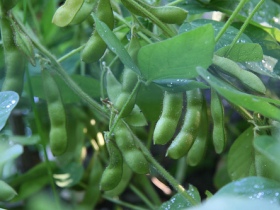Swedish soybeans have high ozone tolerance

The first screening by US Department of Agriculture (USDA) scientists of the American ancestors of soybeans for tolerance to ozone and other stresses had an eye-opening result: The world superstars of stress resistance hailed from a little village in far northern Sweden, called Fiskeby.
The screeners, geneticist Tommy Carter and plant physiologist Kent Burkey, are with the Agricultural Research Service (ARS) in Raleigh, NC. Carter works in the ARS Soybean and Nitrogen Fixation Research Unit, and Burkey is in the agency’s Plant Science Research Unit. ARS is USDA’s principal intramural scientific research agency.
Salt tolerance
After analyzing thousands of soybean types to generate the family tree of North American soybeans, Carter found 30 ancestors, which together account for 92% of the genetic material in North American soybeans.
He screened these ancestors first for salt tolerance. Two lines of vegetable soybeans, Fiskeby 840-7-3 and Fiskeby III, were the most salt tolerant.
Carter screened for aluminium tolerance, and again the Fiskeby plants stood out—and the same thing happened when he screened for tolerance to drought and high ozone levels. The Fiskeby plants also were found to be resistant to iron deficiency and toxic soil aluminum.
Increased ozone tolerancee
The scientists searched breeder pedigree records and found that only a few US cultivars trace their ancestry to the Fiskeby stress-tolerant types.
This indicates that there is great potential to increase tolerance to ozone and other stresses in North American soybeans by adding genes from Fiskeby.
Burkey, Carter and Jim Orf, a geneticist at the University of Minnesota at St. Paul, have crossed Fiskeby III with ozone-susceptible Mandarin Ottawa soybeans and developed 240 breeding lines from the offspring.
With the help of funding from the United Soybean Board of Chesterfield, Mo., the team is mapping the genes in these lines to see which are connected to resistance to ozone and the other stresses.
The Swedish soybeans appear to have an even more pronounced resistance to ozone than to the other stresses. Understanding the ozone effect may be key to unravelling the secrets of the broad stress resistance of the Swedish soybeans.
Read more about this research, which supports the USDA priority of promoting international food security, in the July 2011 issue of Agricultural Research magazine.
Burkey and Carter published a paper on this research in Field Crops Research, a peer-reviewed international journal.











